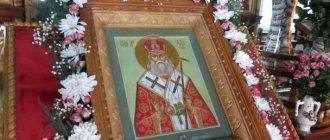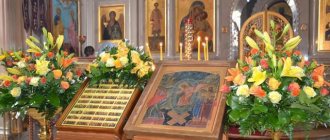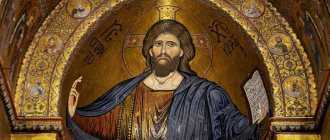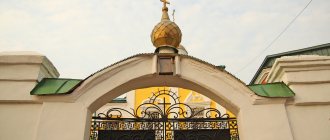| Philermos Icon of the Mother of God |
Philermos Icon of the Mother of God Hodegetria
Veneration October 12 and September 24 (Greek [1])
The miraculous icon, known under the name of Hodegetria Philermos, according to ancient legend, was painted by the holy evangelist Luke. Church hymns mention that this icon of the Most Holy Theotokos was painted during her earthly life [2]. Saint Luke brought the icon to the Nazarenes who dedicated their lives to monastic asceticism [3]. She stayed with them for three centuries.
Later, the icon was transferred to the Holy City of Jerusalem, where it was also to remain for a short time. In the 430s, the Blessed Queen Eudokia retired to the Holy Land and from there, with a special blessing, sent the icon to the sister of her crowned husband, the Blessed Pulcheria [4]. The latter, in front of a large crowd of people, honorably placed a priceless image in the newly built Blachernae Church of Constantinople. In the temple, many believers received healings by praying before the miraculous image of the Queen of Heaven.
In the hands of the Knights Hospitaller
For more than seven centuries, the miraculous shrine was kept in Constantinople, but after it was captured and plundered by the Crusaders in 1203, the icon was again transferred to the Holy Land. It was then that the miraculous image ended up in the hands of the Roman Catholics - the Knights of St. John, who were at that time in the city of Acre. After 88 years, Acre fell to the Turks and during the retreat the knights transported the icon to the island of Crete. After a short stay there, the image was transported to Rhodes in 1309, where it remained in the hands of the knights for more than two centuries. Here the image was placed in the rebuilt ancient basilica of the monastery on Mount Filerimos, which is where the name of the Filerimos icon came from.
At the end of July 1522, the hundred-thousand-strong army and fleet of the Turkish Sultan Suleiman I Kanuni landed on the island and began the siege of the fortress and capital of the Order of St. John. When the city fell at the end of that year, the terms of surrender of the island received and accepted by the Turkish Sultan stated:
«
so that the cavaliers would be allowed to stay on the island for 12 days until they transfer to the ships the relics of the Saints (among them was the right hand of St. John the Baptist and the Cross from part of the wood of the Holy Cross), sacred vessels from the Church of St. John, all sorts of order rarities and their own property: so that the churches located on the island would not be desecrated: for which the cavaliers, for their part, cede both Rhodes and the islands belonging to it to the Porte
.»
Having left Rhodes, the knights transported shrines around Italy for more than seven years, visiting the island of Candia, Messina, Naples, Nice, Rome, fearing to become dependent on any supreme power. On March 24, 1530, the Holy Roman Emperor Charles V transferred to the order a number of possessions, headed by the island of Malta, where on October 26 of the same year, along with the Grand Master of the Order and the Council, the order's shrines arrived. Her place of residence was Fort St. Angel, and later the Castle of St. Michael - the main residence of the Order of Malta. The victory over the Turks who attacked the island in 1565 is attributed to the help of the Mother of God. Since August 21, 1568, the relics of the knights were in the Church of Our Lady of Victory, built by the master of the order Jean de La Valette, and on March 15, 1571, the miraculous icon and relics of the order were solemnly transferred to the new city of La Valette. Here, in the Cathedral of St. John, a side chapel of the Lady of Philermos was built specifically for the revered icon.
In 1798, the island of Malta was captured by the French without visible resistance and many of the order's valuables were plundered. However, the greatest Christian shrines were saved: leaving Malta on the orders of the French government, the Grand Master of the Order of Gompes took with him the right hand of St. John the Baptist, part of the Life-giving Cross of the Lord and the miraculous Philermo image of the Mother of God.
In Russia
The adoption of the title of Grand Master by Russian Emperor Paul I determined the arrival of the order's relics in Russia and the transfer of the Maltese shrines to Gatchina on October 12, 1799 (see more details). By the will of the sovereign, a 7-pound golden chasuble studded with precious stones was made for the Filermos icon, placed in the court church of Gatchina.
Since 1801, the Maltese shrines have been located in the imperial Winter Palace, in the richly decorated Cathedral of the Savior Not Made by Hands. A terrible fire in December 1837 did not damage them. After the restoration of the Winter Palace, on March 25, 1839, Metropolitan Philaret of Moscow, in the presence of the royal family, consecrated the renovated cathedral, in which the shrines took their rightful place. Since the court cathedral was usually closed to wide public access, at the solemn consecration of the Gatchina St. Paul Cathedral in 1852, parishioners dared to petition Emperor Nicholas I to bring the shrines to the new Gatchina Cathedral. The emperor did not dare to part with the relics, but gave orders to annually transfer them to Gatchina for worship. In the same year he ordered:
«to instruct one of the good icon painters to copy a copy from the image of the Blessed Virgin Mary, located in the larger church of the Winter Palace, brought from Malta, painted by Luke, and after making a silver gilded frame for the painted image, similar to the one that now exists, to deliver the made image to the Gatchina Cathedral, where it should be placed on the lectern
.»
The highest command was fulfilled and the list found its place in the St. Paul Cathedral. At the same time, from 1852 to 1919, the miraculous image itself, as ordered by Emperor Nicholas I, along with other Maltese shrines, was transported to Gatchina. There, on October 12, a crowded religious procession took place from the palace to the cathedral church, where the shrines were exhibited for worship, and on October 22 they returned to the Winter Palace.
Meanwhile, the Order of Malta, banned in the Russian Empire by the decrees of Emperor Alexander I in 1810-1817, did not give up attempts to return the shrines. In 1915, during the conditions of the alliance in the First World War, by order of the Passion-Bearer Emperor Nicholas II, a photograph was taken from the miraculous Philermo Icon of the Mother of God. It was transferred to the Malta Museum at the request of the senior judge and chairman of the judicial chamber of the island of Malta, Pullicino.
Export after the revolution
From the letter of the rector of the Gatchina St. Paul Cathedral, Archpriest Andrei Shotovsky, to the People's Commissariat of Education it follows that:
«1919, January 6th, the Protopresbyter of the Winter Palace, Father A. Dernov, brought shrines: part of the tree of the Life-giving Cross of the Lord, the right hand of St. John the Baptist and the icon of the Philermo Mother of God. All these shrines were brought in the form in which they were always brought to the cathedral on October 12, that is, on the icon of the Mother of God - a robe and caskets for the relics and the Cross. After the Divine Service performed by the Petrograd Metropolitan, these shrines were exhibited for some time in the cathedral for worship by the believing residents of the city of Gatchina
.»
Further in his letter, Father Andrei reported that on October 13, Count Pavel Ivanovich Ignatiev appeared at the cathedral “ with some military man
,” and confiscated the shrines. The rector of the cathedral, Archpriest John of the Epiphany, packed the shrines in a case, and Ignatiev took them to Estonia, to the city of Revel (now Tallinn). In 1923, the Italian government turned to Soviet Russia with a request to “return” the shrines, but by that time they were already abroad. In 1925, the Italian Ambassador to the USSR, in secret from the Russian Orthodox Church and the laity, was given a copy of the Filermos icon from the Gatchina St. Paul Cathedral. This icon was kept for fifty years on Via Condotti in Rome at the residence of the Order of Malta, and since 1975 it has been in the Basilica of Mary of the Angels in the city of Assisi.
Meanwhile, the original shrines were kept for some time in the Tallinn Alexander Nevsky Orthodox Cathedral, and then were secretly transported to Denmark, where the Dowager Empress Maria Feodorovna was in exile. After her death, on October 13, 1928, in the suburbs of Copenhagen, her daughters, Grand Duchesses Ksenia and Olga, handed over the shrines to the head of the Russian Orthodox Church Outside of Russia, Metropolitan Anthony (Khrapovitsky). They were then placed in the Orthodox Cathedral of Berlin. But in 1932, foreseeing great disasters in Germany, Bishop Tikhon of Berlin handed over the shrines to the King of Yugoslavia, Alexander I Karageorgievich.
In Yugoslav lands
King Alexander I kept the shrines with special reverence in the chapel of the royal palace, and then in the church of the country palace on the island of Dedinji. In April 1941, at the beginning of the occupation of Yugoslavia by German troops, 18-year-old King Peter II and Patriarch Gabriel took the great shrines to the remote Montenegrin monastery of St. Basil of Ostrog, where they were secretly preserved.
In 1951, local security officers from the special service “Udba” arrived at the monastery and took the shrines to Titograd (now Podgorica). Then the relics were transferred to the State Repository of the Historical Museum of Cetinje. In the Church, the shrines were considered lost, but in 1968 one of the policemen secretly reported them to the Cetinje Abbot Mark (Kalanya) and Metropolitan Daniel of Montenegro. In 1993, Orthodox bishops managed to rescue from museum storage the right hand of St. John the Baptist and a piece of the Life-giving Cross of the Lord, which were placed in the Cetinje Petrovsky Monastery. On October 30, 1994, at the opening of the Council of the Serbian Orthodox Church, Metropolitan Amfilohije of Montenegro revealed the secret to the Orthodox people. However, the Filerm icon remained in the historical museum of the city of Cetinje, and all attempts by the Orthodox community, laity and clergy to rescue it still remain unsuccessful.
Icon “Blessing of Children”: what it helps with
This relic has long served as a revered family amulet. In temples it was even placed on a special low lectern so that even very tiny children could approach the shrine. The image protects newborns, older children, teenagers, and boys and girls. He will protect your offspring from illnesses, injuries, temptations, disappointments, quarrels, bad habits and bad acquaintances, promote normal development and maturation, guide them on the right path, and warn against mistakes and sins.
The icon is also useful for parents - it will give empathy (the gift of sharing a child’s experiences and listening to his needs), patience, tact, the ability to cope with difficulties and misunderstandings, and a balanced combination of discipline, respect and love for the baby. In addition, the image brings harmony, peace and tranquility to the family - so it will be a welcome surprise for those who are just planning to acquire an heir.
It is known that a mother’s heartfelt prayer is a blessing to children. Therefore, bowing before the shrine, you can ask the Lord for your child’s happiness, prosperity, prosperity, good health, good mood and well-being. Your words will protect your baby from adversity, illness, insurmountable obstacles, and negative emotions.
The relic is often used to overshadow children who are facing some kind of challenge - admission to kindergarten, school, college or institute, long and difficult treatment, transfer exams, change of place of residence. The shrine is also used to bless the bride and groom, instructing them before marriage.
And the image will also be useful to everyone who is involved in raising or teaching children - nannies, coaches, teachers, lecturers and heads of various sections. By offering prayers to him, you will overcome the laziness, mistrust and apathy of the kids, find a common language with them, and instill in the children true Christian values.
Buying the “Blessing of the Children” icon is very simple - you just need to contact our manager to choose the work of the desired size, and soon a precious amber relic, handmade from radiant Polesie gems and small stone chips in strict accordance with Orthodox canons, will decorate your home!
History of the icon
The Philermo Icon of the Mother of God was painted by Saint Luke in the year 46 AD and brought by him to the Antioch Nazarene monks who devoted themselves to Christian asceticism. The image remained there for almost 300 years. Then the icon was sent to Jerusalem.
In 430, the wife of the Emperor of Byzantium, Evdokia, went with pilgrims to visit the Holy Land and from there, with a blessing, she gave it to her husband’s sister, who was called Blessed Pulcheria. With special honors, in front of a large crowd of people, she installed the image of the Mother of God in the new Blachernae Church of Constantinople. Believers rushed to the miraculous icon. They received healing and peace by praying and bowing to the face of the Queen of Heaven.
In 626, the relic, in response to fervent prayers, showed the world a great miracle - it saved Constantinople from being conquered by the Persians. For this, the believers composed a song of thanksgiving, which should be listened to while standing. This action was called an akathist. Constantinople was the habitat of the holy icon for more than 700 years.
Finding the name “Filermskaya”
This period was interrupted by the crusaders; the image of the Ever-Virgin was sent to Jerusalem, where it came into the possession of the Roman Catholic knights from Acre. 88 years later, Acre was conquered by the Turks. Leaving the city, the knights took the icon to the territory of the island of Crete. And in 1309, the image of the Mother of God was transported to Rhodes for as long as 200 years. In the 14th century, a temple dedicated to the Intercessor was erected by the knights for the holy face. The foundation of the destroyed ancient Byzantine basilica, which is located in Ialis on Mount Philermios, was chosen as the site for the building. This church can be seen today and is well preserved. Here they pray, turning to one of the lists made from the icon of the Philermo Mother of God, Catholics and Orthodox (each in their own part of the temple).
In the summer of 1522, a fleet with the invincible army of Sultan Suleiman I set foot on the soil of Rhodes, and the siege of the fortress and capital began. After the fall of the defense, a document on the terms of surrender was adopted. The knights agreed to cede to the Porte and the islands for permission to collect Christian shrines and their own property from the occupied territory within 12 days. The Turks pledged not to destroy the Rhodian monasteries and temples.
In Italy
Wanting to remain independent, the knights transported relics throughout Italy for about 7 years; they were in Naples, Nice, Rome, Messina, and on the island of Candia. Only by 1530 the ordeal ended, Charles V (Emperor of the Roman Empire) transferred the islands of Comino, Gozo, Malta and other territories into the possession of the knightly order. The Fort of the Holy Angel became a haven for shrines, as well as for the Philermo Icon of the Blessed Virgin. And later - the residence of the Order of Malta, the castle of St. Michael.
The miraculous help of the icon of the Most Holy Theotokos is associated with the victory of the knights over the Turks during the attack in 1565. From 1568 to 1571, the holy relics of the knightly order were kept in the Church of Our Lady of Victory. And then all the priceless artifacts were transferred with honor to the new chapel of the Lady of Philermo on the grounds of the Cathedral of St. John (La Valletta).
Where does the name Everlasting Color come from?
The white lily flower symbolizes purity and innocence, which corresponds to the Queen of Heaven, who is also called the Unbrided Bride. But in this case there is also a moment of Divine appearance.
In Greece, on Mount Kefalonia there is a temple in which a true miracle occurs every year. On the day of the Annunciation of the Blessed Virgin, parishioners and pilgrims carry flowers of white lilies, similar to the one that the Archangel Gabriel brought along with the Good News of the birth of the Divine Child to Mary the Virgin. The brought lilies are placed in a glass icon case of the Queen of Heaven without water, where they first dry out, and on the feast of the Dormition of the Mother of God, fresh buds appear on the dry stems and open into flowers.
Information for visitors
- Location of the Philerim Monastery: 15 km southwest of the city of Rhodes along the western coast, 5 km from the city of Iálysos, second name of the city: Triánda.
- Opening hours: 8:00–19:00 (Tue–Fri), 8:30–15:00 (Sat–Sun).
- Ticket price: 3 euros. Children and students from EU countries have free admission. On Sundays from November to March admission is free for everyone.
© Website “On the Roads of the Middle Way”, 2009-2021. Copying and reprinting of any materials and photographs from the site anashina.com in electronic publications and printed publications is prohibited.
Mother's prayer - blessing for children
Lord Jesus Christ, Son of God, prayers for the sake of Thy Most Pure Mother, hear me, Thy sinful and unworthy servant. Lord, in the mercy of Your power my child, have mercy and save him for Your name’s sake. Lord, forgive him all the sins, voluntary and involuntary, that he committed before You. Lord, guide him on the true path of Your commandments and enlighten him and enlighten him with Your light of Christ, for the salvation of the soul and the healing of the body. Lord, bless him in the house, around the house, at school, in the field, at work and on the road, and in every place of Your possession. Lord, protect him under the shelter of Your Saints from a flying bullet, arrow, knife, sword, poison, fire, flood, from a deadly ulcer (atomic rays) and from vain death. Lord, protect him from visible and invisible enemies, from all troubles, evils and misfortunes. Lord, heal him from all diseases, cleanse him from all filth (wine, tobacco, drugs) and ease his mental suffering and sorrow. Lord, grant him the grace of Your Holy Spirit for many years of life, health and chastity. Lord, increase and strengthen his mental abilities and physical strength. Lord, give him Your blessing for a godly family life and godly procreation. Lord, grant me, Thy unworthy and sinful servant, a parental blessing on my child at this time of morning, day, evening and night for the sake of Thy name, for Thy Kingdom is eternal, omnipotent and omnipotent. Amen.









